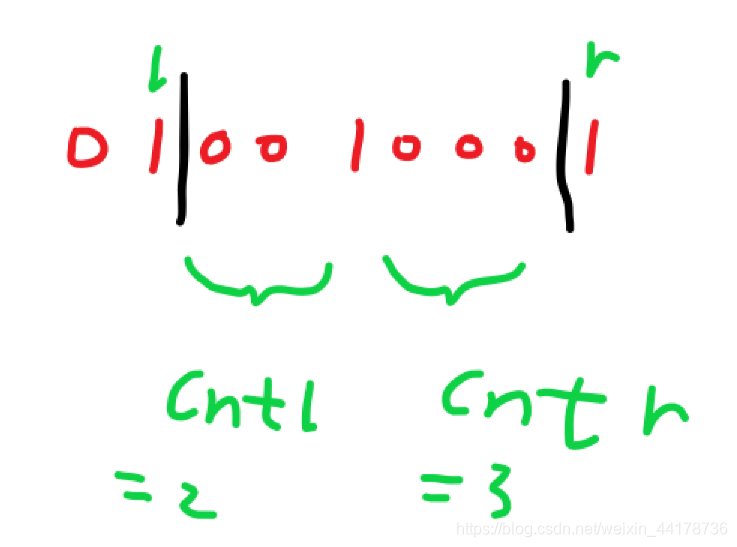LeetCode 1573. 分割字符串的方案数(组合数学)
本文共 1231 字,大约阅读时间需要 4 分钟。
题意:
给你一个二进制串 s (一个只包含 0 和 1 的字符串),我们可以将 s 分割成 3 个 非空 字符串 s1, s2, s3 (s1 + s2 + s3 = s)。请你返回分割 s 的方案数,满足 s1,s2 和 s3 中字符 '1' 的数目相同。由于答案可能很大,请将它对 10^9 + 7 取余后返回。数据范围:s[i] == '0' 或者 s[i] == '1'3 <= s.length <= 10^5
解法:
设tot为1的总数量,如果tot=0,那么答案为C(n-1,2),如果tot!=0,那么:设串下标为[1,n],找到满足s[1,l]=tot/3的最小下标l,找到满足s[r,n]=tot/3的最大下标r,然后统计l+1开始到其右边第一个1之间0的数量cntl,以及r-1开始到其左边第一个1之间0的数量cntr.那么答案为(cntl+1)*(cntr+1),因为左边有cntl+1个空隙可以选择,右边有cntr+1个空隙可以选择.如下图:

code:
class Solution { public: static const int maxm=1e5+5; static const int mod=1e9+7; int d[maxm]; int numWays(string s) { memset(d,0,sizeof d); int n=s.size(); s='p'+s; int ans=0; for(int i=1;i<=n;i++){ d[i]=d[i-1]+(s[i]=='1'); } int tot=d[n]; if(tot==0){ return 1ll*(n-1)*(n-2)/2%mod; } if(tot%3)return 0; int l=1; while(d[l]!=tot/3)l++; int r=n; while(d[n]-d[r-1]!=tot/3)r--; int cntl=0,cntr=0; for(int i=l+1;i<=n;i++){ if(s[i]=='0')cntl++; else break; } for(int i=r-1;i>=1;i--){ if(s[i]=='0')cntr++; else break; } return 1ll*(cntl+1)*(cntr+1)%mod; }}; 转载地址:http://igkv.baihongyu.com/
你可能感兴趣的文章
NetBeans IDE8.0需要JDK1.7及以上版本
查看>>
netbeans生成的maven工程没有web.xml文件 如何新建
查看>>
netcat的端口转发功能的实现
查看>>
netfilter应用场景
查看>>
netlink2.6.32内核实现源码
查看>>
netmiko 自动判断设备类型python_Python netmiko模块的使用
查看>>
NetMizer-日志管理系统 dologin.php SQL注入漏洞复现(XVE-2024-37672)
查看>>
Netpas:不一样的SD-WAN+ 保障网络通讯品质
查看>>
NetScaler的常用配置
查看>>
netsh advfirewall
查看>>
NETSH WINSOCK RESET这条命令的含义和作用?
查看>>
netstat命令用法详解
查看>>
Netstat端口占用情况
查看>>
Netty 4的内存管理:sun.misc.Unsafe
查看>>
Netty channelRegistered\ChannelActive---源码分析
查看>>
Netty WebSocket客户端
查看>>
netty 主要组件+黏包半包+rpc框架+源码透析
查看>>
Netty 异步任务调度与异步线程池
查看>>
Netty中实现多客户端连接与通信-以实现聊天室群聊功能为例(附代码下载)
查看>>
Netty中集成Protobuf实现Java对象数据传递
查看>>